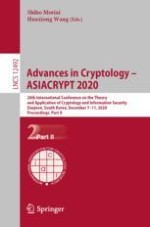The three-volume proceedings LNCS 12491, 12492, and 12493 constitutes the proceedings of the 26th International Conference on the Theory and Application of Cryptology and Information Security, ASIACRYPT 2020, which was held during December 7-11, 2020. The conference was planned to take place in Daejeon, South Korea, but changed to an online format due to the COVID-19 pandemic.
The total of 85 full papers presented in these proceedings was carefully reviewed and selected from 316 submissions. The papers were organized in topical sections as follows:
Part I: Best paper awards; encryption schemes.- post-quantum cryptography; cryptanalysis; symmetric key cryptography; message authentication codes; side-channel analysis.
Part II: public key cryptography; lattice-based cryptography; isogeny-based cryptography; quantum algorithms; authenticated key exchange.
Part III: multi-party computation; secret sharing; attribute-based encryption; updatable encryption; zero knowledge; blockchains and contact tracing.
